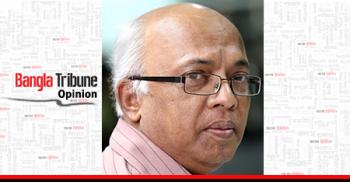 August, for Bengalis as also for people across the Indian subcontinent, is a reminder of some of the more harsh realities which have underpinned life for them. Rabindranath Tagore died in August 1971. On 18 August 1945, Netaji Subash Chandra Bose perished or disappeared, depending on which point of view you are inclined to accept. It is a month that claimed the lives of Bangabandhu Sheikh Mujibur Rahman and his family.
August, for Bengalis as also for people across the Indian subcontinent, is a reminder of some of the more harsh realities which have underpinned life for them. Rabindranath Tagore died in August 1971. On 18 August 1945, Netaji Subash Chandra Bose perished or disappeared, depending on which point of view you are inclined to accept. It is a month that claimed the lives of Bangabandhu Sheikh Mujibur Rahman and his family.
And August remains a month when history was mutilated in the subcontinent. Legacies were destroyed, homes were razed, millions were forced out of their ancestral homes, tens of thousands of young women — Muslims, Hindus, Sikhs — were abducted, raped and killed. Neighbours who had inhabited villages and towns in a spirit of camaraderie spanning generations turned on one another. They were no more compatriots but people tribalised into communalism brought about by skewed ideas of religion.
Seventy-one years ago in 1947, a summer of madness ran riot across India, destroying lives, razing homes and putting heritage to flight. The partition of India, for all the association you bring to it of freedom, of a tryst with destiny (in Nehru’s oft-quoted phrase) remains a metaphor for horror brought about through sheer fratricide. In August 1947, as Jawaharlal Nehru took charge of a free India and Mohammad Ali Jinnah assumed power in Pakistan, as many as a million Hindus, Muslims and Sikhs died in a frenzy they had no hand in the making of. No fewer than fourteen and a half million people left their ancient homes, on both sides of the border decreed by Cyril Radcliffe, to find refuge and a future in unfamiliar new homelands. Radcliffe did the job in a bare thirty-six days.
Too many things went wrong in that terrible summer — and before it. Here was Radcliffe, with precious little understanding of Indian history, carving up the land in line with murderous specifications. A living room went to Pakistan, the kitchen found space in India. The Chakmas in Chittagong (now Chattogram) hoisted the Indian flag on August 14, little knowing that they had been thrown into Pakistan’s lap. They were soon put down. But not so easily put down were the riots which kept Calcutta (now Kolkata) in their grip for four days in August 1946, killing anywhere between five thousand and ten thousand Hindus and Muslims. It was a disaster that ought not to have happened. To this day, you wonder why the Muslim League needed to call a Direct Action Day on August 16, why the administration, headed by a Muslim League leader, so zealously declared the day a holiday in Bengal. It ended in carnage. Who do you hold guilty? And can you forgive the men who caused it all?
Guilt and forgiveness are ideas you raise when you go back to a reappraisal of the politics Jawaharlal Nehru pursued in the aftermath of the Cabinet Mission Plan of July 1946. Jinnah, for all his doubts, had gone along with the plan, which fundamentally meant to keep India intact. Yet Jinnah had also come under fire for what was perceived to be his deviation from the Lahore Resolution of 1940. Nehru gave him the perfect opportunity to wriggle out of his predicament. Observe Nehru at his news conference of July 10, 1946:
“The first thing is we have agreed to go into the Constituent Assembly and we have agreed to nothing else … What we do there, we are entirely and absolutely free to determine. We have committed ourselves on no single matter to anybody.”
Did Nehru deliberately torpedo the Cabinet Mission Plan? What he most certainly did was give Jinnah a good excuse to repudiate his earlier acceptance of the plan and revert to the Pakistan question. That happened on July 27. Barely a month later, the Calcutta killings commenced. Historians, hordes of them, will tell you that after those killings, the vivisection of India turned into a fait accompli. And supposing those killings had not happened? The expatriate Indian historian Neeti Nair gives you new food for thought in her new work, ‘Changing Homelands: Hindu Politics and the Partition of India’. She speaks of the Punjabi Hindu leader Gokul Chand Narang, who tells an audience twenty years after partition: “I was chairman of a public meeting. I said I would agree to Pakistan, but never to parity.” A large chunk of Punjabi Hindus, notes Nair, preferred partition to having Hindus and Muslims share equal space and opportunities in a united India.
Which sends you into paroxysms of regret. Would Deshbandhu CR Das and Netaji Subhas Chandra Bose be able to lead a united India into freedom? The answers are lost in the maze which sometimes comes into a reconfiguring of history. Das died young at age 51 in 1925, and Bose disappeared a full two years before the bloodletting of August 1947. Gandhi, the remaining man of stature, shrank into redundancy as freedom came closer, resigned to the barbaric workings of destiny. Jinnah, having started off on the false premise that religious communities were actually nations, had little idea of what Pakistan meant. His whimsicality made a mockery of the Lahore Resolution, when he suddenly remembered that it spoke of not two states but one in the Muslim-majority regions of the country. As for Nehru, he did not appear to mind Pakistan taking shape as long as it left an India for the Congress to govern.
There is the quixotic you recall as you revisit August 1947. In the earlier part of the year, Huseyn Shaheed Suhrawardy came forth with his plan for a sovereign, undivided Bengal. You ask: having been with the Muslim League, having had a hand in the making of the Calcutta riots in 1946, did he really expect people to take him seriously? On a more elevated scale, Sarat Chandra Bose called for a sovereign socialist republic of Bengal. That fell through, though. The current of history had by then overtaken both Suhrawardy and Bose. And history, again, was what Mountbatten thought he was forging anew when essentially he was driving a knife through it. He came up with the June 3 Plan and put it into macabre implementation, imagining all the while that he could be governor-general of both India and Pakistan. Jinnah’s brusque dismissal of the idea was only natural.
In the end, partition left Bengal and Punjab wounded beyond measure. Sixty-four years after that summer of madness, descendants of the partition generation remember lost homes in Punjab, in Bengal, indeed in other parts of the old India. The wounds, transferred generationally, have not quite healed.
That summer of madness, noted the Urdu poet Faiz Ahmed Faiz, was a ‘night-bitten’ morning, a ‘pockmarked’ dawn.
Syed Badrul Ahsan is the Editor-in-Charge at The Asian Age


